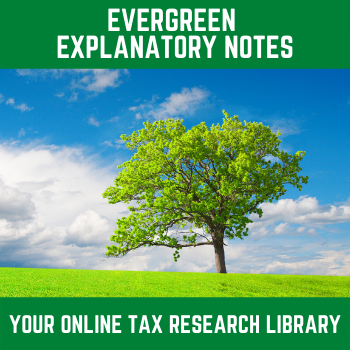Last updated: September 16 2021
The Principal Residence Exemption, Part 1: The Basics

Marco Iampieri B.A., JD, M.B.A. with excerpts from Evergreen Explanatory Notes
Advisors should be aware of the definition of principal residence and the Canadian tax implications regarding the sale of a principal residence. Awareness of the provisions outlined in this article will provide detailed information about qualifying for the principal residence exemption and calculating the optimal time to dispose of capital real property. This is part 1 of a 3 part series on the topic.
This article contains excerpts from EverGreen Explanatory Notes research library. Subscribe to EverGreen Explanatory Notes. – will include the ad visual and link
Definition of Principal Residence. The definition of principal residence is defined under the Income Tax Act, Part I – Income Tax, Division B – Computation of Income, Subdivision C – Taxable Capital Gains and Allowable Capital Losses, section 54.
A principal residence is a house, cottage, condo, duplex, apartment, trailer or other habitable unit that is ordinarily inhabited by a taxpayer during a taxation year or the taxpayer’s spouse,  common-law partner, former spouse, former common-law partner or by a child of the taxpayer.
common-law partner, former spouse, former common-law partner or by a child of the taxpayer.
The definition of principal residence also includes a leasehold interest in a housing unit or a share of the capital stock of a co-operative housing corporation acquires for the sole purpose of acquiring the right to inhabit a housing unit owned by the corporation and that is owned in the year by the taxpayer. Where the taxpayer is a personal trust, the housing unit was ordinarily inhabited in the calendar year by a specified beneficiary of the trust for the year, by the spouse or common-law partner or former spouse or common-law partner of specified beneficiary or by a child of a specified beneficiary.
The definition of principal residence is deemed to include the land subjacent to the housing unit and such position of any immediately contiguous land as can reasonably be regarded as contributing to the use and enjoyment of the housing unit as a residence, except that where the total area of the subjacent land and that of the portion exceeds ½ hectare, the excess shall be deemed not to have contributed to the use and enjoyment of the housing unit as a residence unless the taxpayer establishes that it was necessary to such use and enjoyment.
Income Tax Folio S1-F3-C2, Principal Residence provides a detailed discussion of the principal residence exemption. Income Tax Folio’s do not have the force of law. While the comments in a particular income tax folio or income tax interpretation bulletin may relate to provisions of the law in force at the time they were made, the income tax folio or income tax publication are not a substitute for the law. The reader of income tax folios or income tax interpretation bulletins should consider the comments considering the relevant provisions of the law in force for the tax year being considered.
Generally, each household can identify one property as a principal residence for each year that the property is owned and have the realization of any capital gains that have accrued to the identified property sheltered from Canadian income tax.
Income Tax Provisions and Administrative Guidance in Claiming the Principal Residence Exemption
Once a taxpayer elects for a property to be their principal residence, the capital gain arising from the sale of the property will usually be nil because of the formula supplied in s. 40(2)(b) of the Income Tax Act. For taxation years after 2015, any disposition of a principal residence must be reported on Schedule 3 and T2091 Designation of a Property as a Principal Residence by an Individual (Other Than a Personal Trust) must be completed.
History of Principal Residence Exemptions
|
Time Period |
Principal Residence Tax Implications |
|
Pre 1972 |
No capital gains tax – no tax on accrued gains on any capital assets |
|
1972 to 1981 |
One principal residence designation allowed for each year for each spouse |
|
1982 to date |
One principal residence designation allowed for each year to each conjugal relationship (married or common-law) |
|
1998 to 2001 |
Same-sex couples could elect conjugal status, thereby limiting their tax-exempt residences to one per unit |
|
2001 to date |
Same-sex couples required to limit themselves one principal residence designation per year per conjugal relationship |
Calculation of the Principal Residence Exemption
The capital gain on the property is first calculated, using regular rules for capital gains and losses found at paragraph 40(1)(a) of the Income Tax Act: Capital Gain = Proceeds of Disposition – (Adjusted Cost Base + Expenses of Disposition). The principal residence exemption exempts a portion, or all of the capital gain realized on the disposition of a principal residence and is determined as follows:
|
Total Gain |
X |
(Number of Years designated as Principal Residence + 1) |
|
Number of Years the property was owned |
The exempt portion of the capital gain realized on the disposition of a taxpayer’s principal residence adds a one (1) to the number of years designated as principal residence because two residences will be owned in the year that the taxpayer moves from one residence to another.
Stay tuned for part 2 on the denial of the principal residence example and part 3 which will consider special cases, which will be published later this month. . All information contained within these articles is duplicated and expanded upon throughout Evergreen Explanatory Notes, which provides taxation law and Canada Revenue Agency documentary guidance regarding personal topics, GST topics and corporate topics. Subscribe online today!

